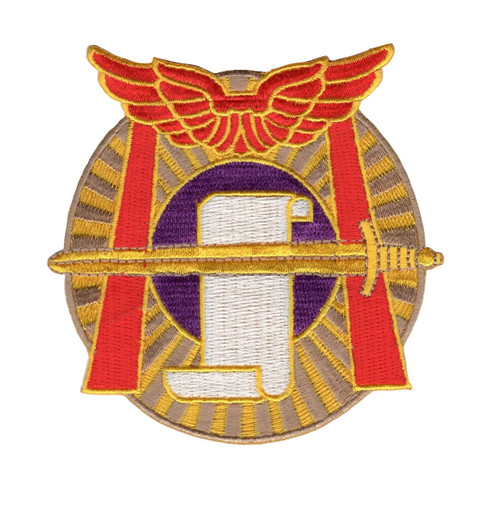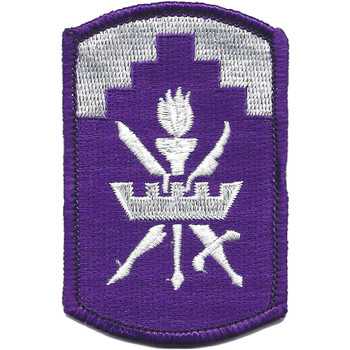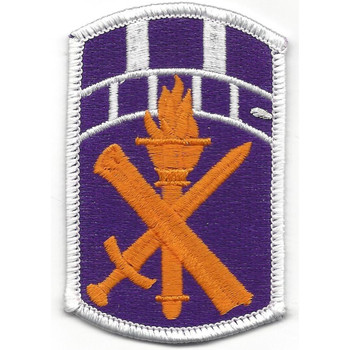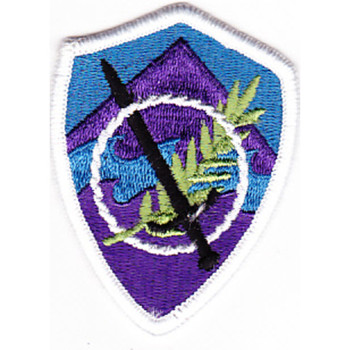Description
1ST Civil Affairs Battalion Unit Crest Patch (U.S. Army) 3.5" x 3.5" Embroidered Patch with Iron-On Backing
Superior Materials: Made with premium polyester thread and durable twill fabric, ensuring long-lasting color and strength.
Advanced Embroidery Technology: Crafted using the most advanced embroidery machinery, guaranteeing intricate detail, sharp lines, and consistent quality every time.
Easy Iron-On Application: Features a heat-activated adhesive backing for quick, no-sew attachment. Simply position, iron, and press for a secure bond.
Versatile Use: Perfect for personalizing jackets, backpacks, uniforms, or any fabric surface that needs a touch of personality.
Durable and Washable: Designed to withstand everyday wear and occasional washing without fading or fraying.
Formations & Origins
The 1st Civil Affairs Battalion traces its lineage back to the early roots of civil-military operations during and after World War II, but it was officially activated under its current designation in the modern era of global, asymmetric warfare. While Civil Affairs as a discipline began in earnest during the post-war occupations of Germany and Japan—where military forces had to work alongside civilians to rebuild shattered societies—it was in the crucible of post-9/11 conflicts that the need for specialized, adaptable civil affairs units became indispensable.
The 1st Civil Affairs Battalion, a unit within the U.S. Army’s Civil Affairs and Psychological Operations Command (Airborne), was stood up to operate in complex environments where diplomacy, cultural understanding, and stabilization efforts were as vital as kinetic combat power. Civil Affairs soldiers are the Army’s warriors of peace, often inserted deep into politically sensitive areas, working shoulder to shoulder with local leaders, NGOs, and government agencies to stabilize regions torn by war, disaster, or unrest.
Based out of Camp Pendleton, California, the battalion’s location under the United States Marine Corps' jurisdiction reflects its joint interoperability. Though it is an Army unit, its mission is to operate in support of all branches and often works alongside Marines, Special Forces, and coalition partners across the globe.
Notable Commanders
As a relatively small and specialized unit, the 1st Civil Affairs Battalion doesn’t always operate in the limelight where high-profile generals tend to walk. Its commanders have often been quiet professionals—experienced officers with backgrounds in both conventional warfare and regional diplomacy. These leaders are selected not just for tactical competence, but for cultural sensitivity, negotiation skills, and the ability to lead small, autonomous teams in volatile environments.
Commanders of the battalion are known for a rare blend of academic and combat experience—many hold advanced degrees in international relations, political science, or development studies while having deployed multiple times to regions like the Middle East, Africa, or Southeast Asia. Their leadership is built around influence, coordination, and local empowerment, rather than direct combat dominance.
Major Campaigns/Operations
The 1st Civil Affairs Battalion came into its own during the post-9/11 era, particularly in the operations surrounding Iraq and Afghanistan. In both theaters, Civil Affairs teams played a critical role in reconstruction efforts, tribal diplomacy, governance development, and humanitarian missions.
In Iraq, battalion elements operated across Anbar Province, Baghdad, and Mosul, engaging local leaders, assisting in rebuilding hospitals, restoring power and water infrastructure, and coordinating with coalition forces to reduce insurgent influence. In many cases, these soldiers served as the face of the American military to civilians—working unarmed or lightly armed, dressed in soft gear, and equipped with not just maps and comms gear, but laptops, interpreters, and local contracts.
In Afghanistan, their mission was even more complex. The battalion helped establish local governance in remote villages, coordinated aid delivery in Taliban-contested regions, and brokered agreements between tribal elders and Afghan National Security Forces. Their operations were critical in the larger strategy of “winning hearts and minds,” building legitimacy for local governments, and undermining insurgent propaganda.
Beyond the Middle East, the battalion has supported humanitarian assistance and disaster relief missions globally, from the earthquake in Haiti to typhoon recovery in the Philippines. Their work in Africa includes stabilizing post-conflict areas and supporting partner nations through education, medical assistance, and civil infrastructure improvement.
Specialized Role/Equipment
Civil Affairs soldiers are unlike any other troops in the Army. Operating in small teams—usually four to six soldiers—they are trained to assess, engage, and influence local populations. They are the strategic sensors and humanitarian diplomats of the battlefield, tasked with understanding the human terrain and building relationships that can outlast the sound of gunfire.
Their kit is different. While still wearing standard issue when necessary, Civil Affairs soldiers often operate in civilian attire or in more discreet tactical uniforms. Their tools include satellite communication kits, biometric scanners, cultural terrain analysis software, and negotiation materials. Many speak multiple languages and undergo advanced cultural immersion training.
The battalion is often attached to Special Operations units, giving it a high operational tempo and exposure to non-permissive environments. Civil Affairs Teams, or CATs, are often deployed with or in advance of combat units, conducting civil reconnaissance, identifying civil vulnerabilities, and linking military efforts to local civilian objectives.
Acts of Heroism
Heroism in the 1st Civil Affairs Battalion doesn’t always look like charging a hill or holding a line under fire—though there have been those moments too. Their bravery lies in walking into hostile villages with no backup, navigating tribal politics, defusing ethnic tensions, and risking their lives to protect civilians caught in the crossfire.
In Iraq, teams from the battalion routinely operated in areas saturated with IEDs and insurgents. One team leader, despite suffering injuries from a roadside bomb, refused evacuation until the mission of coordinating a medical delivery to a local hospital was complete.
In Afghanistan, soldiers of the battalion were ambushed while conducting a governance assessment mission. One NCO returned fire to allow his interpreter and two local council members to escape, later being awarded the Bronze Star with Valor. Another soldier helped coordinate the extraction of a village elder targeted by the Taliban for cooperating with coalition forces—personally driving through hostile territory to get him and his family to safety.
Their acts of valor are often unsung, hidden beneath layers of diplomatic discretion. Yet their courage is as real as any front-line combat soldier’s, and their impact can sometimes change the course of a conflict in quieter, more lasting ways.
Legacy & Notable Achievements
The 1st Civil Affairs Battalion represents the future of warfare—where influence, stability, and legitimacy are just as important as firepower. Their motto, reflected in their crest and patch, is a constant reminder that success in modern conflict isn’t measured solely by territory taken, but by lives stabilized, governments restored, and partnerships formed.
Their legacy is carried in countless reconstructed schools, restored clinics, village councils that survived insurgency, and international partnerships that blossomed from the seeds they planted.
The unit crest and patch are rich with symbolism: often bearing imagery tied to global outreach, civic strength, and the unification of military and civilian effort. It is a badge earned through service in the shadows, far from the fanfare, in places where diplomacy must be backed by quiet steel.
As global instability grows more complex, the role of the 1st Civil Affairs Battalion becomes even more crucial. They are the bridge between force and peace, the handshake after the hammer, the unit that makes victory sustainable.
They don’t seek the spotlight—but when the mission demands it, they are, in every sense of the phrase, first in.







